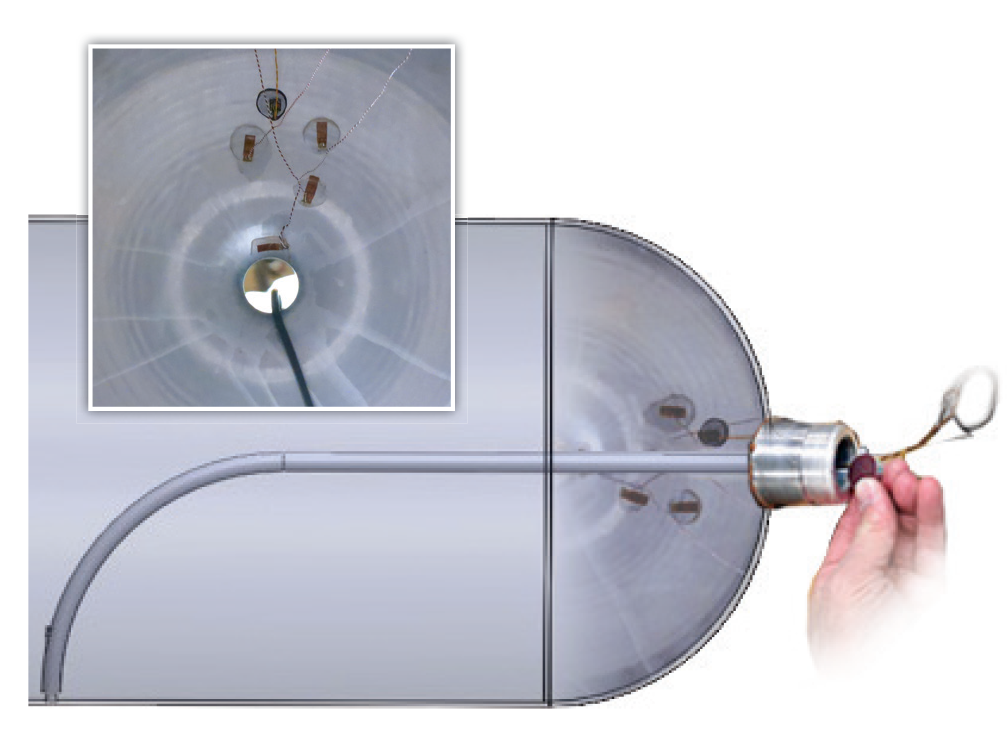COPVs were developed in the 1960s to reduce weight and cost of fluid storage. Today’s COPVs push the traditional design and operational boundaries and demand more complete measurements and flight-like test facilities to be adequately understood and qualified for flight. Recently, the NESC collaborated with LSP and CCP on several COPV anomaly investigations and design qualifications that leveraged NASA’s existing instrumentation suite and nondestructive evaluation methods, which resulted in several innovative measurement capabilities and the development of a full-scale COPV test facility.
The NESC integrated instrumentation and NDE expertise from AFRC, LaRC, MSFC, and WSTF along with contract partners, to pioneer diagnostics that have enhanced our fundamental understanding of COPV mechanical and thermal responses. These test datasets represent some of the most comprehensive COPV measurements available for anchoring thermal/structural models of vessels operating in extreme environments such as densified liquid oxygen and high pressure cryo-helium. The integrated instrumentation suite received simultaneous input from a variety of sensors including conventional strain gages; fiber optic sensing system (FOSS) strain and temperature sensors; thermocouples; resistive temperature detectors; silicon diode temperature sensors; submersed and cryogenic linear variable differential transducers for axial growth; and pressure sensors. The suite could also accommodate other types of data like those obtained for digital image correlation strain and displacement; volume growth; and from acoustic emission and eddy current inspections.
Several new instrumentation methodologies were developed that provided first-time COPV measurements in regions previously unexplored and under extreme pressure and temperature environments. One innovative method enabled the installation of sensors inside an as-built, full-scale COPV using endoscopic techniques to perform a “ship in a bottle” application of strain and temperature sensors on the COPV’s internal liner surface through a 1-inch diameter pressure inlet port at a depth of 5-feet from the port access (Figure 1). Beyond the difficult installation access challenges, sensor bonding methods were developed for these high-strain, cryogenic environments. This technique provided direct measurements of COPV liner strain and temperature during processing and testing that proved critical to validate COPV computational models and assess thermal/structural margins. Additional innovative techniques include fiber optic strain sensors bonded to the composite outer surface subjected to submerged cryogenic conditions, wire-wound strain gages that survived composite microcracking, and an instrumentation feedthrough system to transmit internal sensor signals under high pressure, cryogenic conditions.
The NESC team also developed a COPV flight-like ground test system at WSTF (Figure 2). This test facility included a simulated launch vehicle upper stage and densified liquid oxygen and cryogenic helium pressurization systems that closely duplicated the launch vehicle environment in support of the “test like you fly” principle. This system required significant creativity from NASA experts at GRC, KSC, MSFC, SSC and WSTF, and contractors from across the country to design, build, and operate this unique test system in less than 10 months. Existing hardware components were leveraged along with expertise from multiple NASA Centers to accomplish this technical and schedule achievement. This test facility enables the precise control needed to achieve flight-like pressurization rates and environments for full-scale COPV testing. The facility’s extensive data acquisition system collects data from a suite of sensors recording COPV measurements and environmental conditions.
These innovative COPV measurement and testing techniques were vital in understanding the design, robustness, and flammability risks associated with the usage of COPVs for NASA missions flown by Commercial Resupply Services, LSP, and CCP.
For more information, contact:
Peter A. Parker, LaRC, peter.a.parker@nasa.gov
Michael L. Meyer, GRC, michael.l.meyer@nasa.gov































